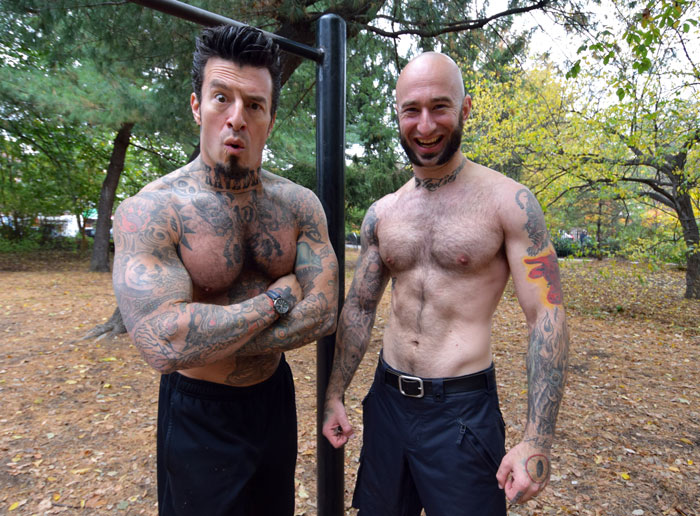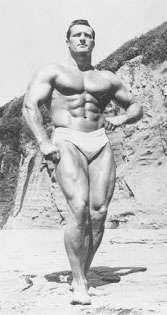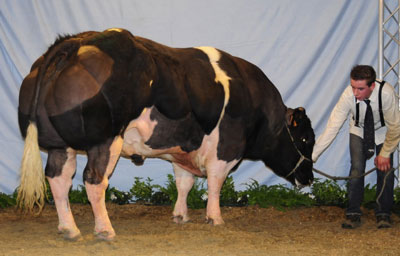
I’ve found that these days I keep getting asked the same questions over and over. Why did you get those lame tattoos? How come your face looks so much older than your body? Who are you, and what are you doing in the girls’ locker room?
That’s my personal life, but in my life as a coach I get a lot of repetitive questions too. Since I wrote C-MASS, here is a doozy that crops up over and over again:
How much muscle can I gain without steroids?
Yeah, you’ve heard it too, right? Well I can’t promise you that I can give you a concrete answer, but at my age I sure am getting good at rambling—so if you’ve got five minutes, stick around and listen to old Uncle Paul. There’s five bucks in it for you. (There’s not.)
Alright. Let’s start with a baseline. (I’m going to focus on the males here because, well, it’s only the males that seem to care about gaining maximum muscle—forgive me, my bodyweight bodybuilding sisters.) How much does the average untrained dude weigh? Modern stats tell us that the average American male these days weighs around 190 lbs. But modern stats are misleading, because we are interested in muscular bodyweight, right? And let’s face it, the modern generation is the fattest ever. Fat Albert, fat. So let’s go back to the sixties—before the obesity epidemic was in full swing. In that decade, stats tell us that he average male was a much sleeker 166 lbs. Now, this wasn’t a lean, steel-cut “six pack” Kavadlo-type athlete—just a regular, untrained not-fat dude. So let’s make this a pretty rough weight for “Mr. Average”—166 lbs.
Now, the Million Dollar Question: how much muscle could our Mr. Average gain, just through training and eating right?
The problem with answering this question in the modern era can be summed up in one word—drugs. Drugs have skewed Joe Public’s vision of what can be achieved by training, more than most people could even imagine. (More on that in a little bit.) So in order to look at what’s really achievable naturally, we need to go back to a time before steroids hit the training scene.
You might be surprised how far back that actually is. Most people probably associate the first true “steroid-era” with the seventies, and the larger than life physiques of men like Arnold Schwarzenegger and Lou Ferrigno, as seen in the movie Pumping Iron (which was based around the battle for the ’75 Mr. Olympia). In fact, similar (and in some cases, identical) compounds to those used by the seventies crew were already for sale in the US in the late fifties. The Soviets were experimenting with steroid-based drugs for Olympic lifters in the forties, which is no surprise because testosterone was first synthesized in the early thirties. If we go even further, natural testosterone—from animal cajones—was first being injected into humans as far back as the nineteenth century. (Hell—that’s before even I was born. I think.) So bodybuilding drugs ain’t new, kids.
As a good guideline though, we can say that—in America, at least—steroid-based PEDs were not being tested on weightlifters until the fifties. So if we go back to the forties, we should—probably, if not absolutely definitely—be able to find drug-free, natural bodybuilders at their peak. This, in turn, should maybe give us at least a clue how big and lean our Mr. Average could aspire to get, at a push.
So let’s look at arguably the best (and most muscular) bodybuilder from the forties: the guy the other lifters all called “the King of Bodybuilders”: Clarence “Clancy” Ross. Clancy was Mr. America 1945—the biggest bodybuilding title in the world back then. (The Mr. Olympia title wasn’t created by Joe Weider until 1965.) How big was he? He was about 5’10, with 17 inch arms, and he weighed in at 185 lbs pounds, soaking wet.
First things first—to many of you on the fitness scene now, this will seem like a ridiculously light weight for a “big” guy. Hell, lean bodybuilders nowadays sometimes hit the stage at close to 300 lbs! So as a result some of you may be thinking…185? At 5’10?! Did this guy even lift?
Uh, yes, He did. In fact, Clancy was a monster who outlifted 99% of modern bodybuilders: he could curl 200 lbs, bench 400 lbs, squat 500 lbs and—get this—perform a standing press of 320 lbs! (Good luck seeing that in a modern gym.) He was also a big fan of traditional calisthenics.
That 185 sure looked good on old Clancy. He had a six-pack like bricks on a building, pecs like huge slabs, muscular, separated quads, round, thick delts and loaded guns.

Actually, Clancy was undernourished and underweight for his frame when he started training. But if he had been the “average” male weighing 166, that would mean he put on close to 20 lbs of muscle as a result of his training and diet (actually probably more like 25-30 lbs, as Clancy was leaner than the average guy.) There were a tiny number of men in the forties who were bigger than Clancy—George Eiferman is an example—but there are always going to be taller guys or real genetic outliers who screw the curve. The fact remains that Clancy is a great example of what “big” is for a male of good health, average height, and normal-to-excellent genetics.
In reality, when guys ask me about how much muscle they can add, it’s obviously impossible to answer. You’d need to see into someone’s genes to know the answer—to also know their hormone levels, dietary habits and work ethic. But as a good rule of thumb, most men who are not underweight and are dedicated to their training and eat and rest adequately can gain 20-30 lbs of solid muscle via training alone. (Obviously you can dial up or down the numbers according to height.) Clancy is an extreme example—among the world’s best—but as you can see from his photo, 20-30 lbs of muscle on a fairly lean physique is enough to make you jacked as sh**. Hell, if you are lean enough, as little as ten pounds of muscle added to your frame will make you look like a buff dude. Toxic drugs are not required to look great.
At this point, a lot of younger guys will be shaking their head, and saying I’m just an ancient loser who’s setting the bar too low for athletes. (They’re right about the ancient loser part, sure.) I get emails all the time about this guy and that guy who does bodyweight-only on YouTube, and is built like a friggin’ Pershing tank. Many of them weigh 200 lbs with change, and are often sliced to the bone. These men are putting on 40 plus pounds of muscle using bodyweight training, their fans tell me. Well, sure they are. They are on steroids. Do you think you are only allowed to use bodybuilding drugs if you lift weights? Jesus, there’s steroids in all sports now. Hell, even the International Chess Federation started doping tests for steroids in 2003. (I’m not kidding. Look it up.)
Why are so many modern athletes lying about their natty status? A simple law of human behavior. Anything which gets rewarded happens more, and anything which gets punished happens less. There are lots of rewards for lying about drug use—more fans, more views, more sponsorship, more respect, etc.—and plenty of punishments for telling the truth—stigma, being banned from sports, jailtime, etc. Of course these guys lie: I don’t even blame them. The problem is though, it creates false expectations, particularly for the younger athletes. They think they suck, or their training sucks, because they don’t look like some juiced up balloon in six months. As a result, they either get despondent and quit training—and so lose a myriad of lifelong benefits—or figure it out and take the drugs, ruining their hormonal profiles and setting up a future health minefield along the way.
It’s understandable that so many people overestimate the amount of muscle that a natural athlete can put on, because drugs have skewed their view of reality beyond belief. To see just how much drugs have changed the picture, check out the biggest bodybuilders after drugs began to infiltrate the scene. Let’s take a look in time lapse, every twenty years:
- The best bodybuilder in the world in 1945 (Clancy) weighed 185 lbs.
- Twenty years later, the best bodybuilder—the 1965 Mr. Olympia, Larry Scott—weighed 200 lbs: heavier AND leaner than any Mr. America in the forties. (All this, and he was three inches shorter than Clancy!) What caused this huge jump? By now bodybuilders were using the oral steroid Dianabol and almost definitely injectable steroids like Deca-Durabolin, which was available from the late fifties. They were probably taking fairly light to moderate doses (by modern standards) and only using the drugs before competition, coming off them for long periods.
- Twenty years later—it’s 1985 and the world’s greatest is Mr. Olympia, Lee Haney. At 5’11, Haney weighed in at a phenomenal 245 lbs. With paper-thin skin and dehydrated, Haney weighed about 70 lbs more than old Clancy! What caused this quantum leap? Maybe Haney was just more intense in the gym, or trained better? In fact, no—by all accounts, Clancy Ross could outlift Lee Haney on his best day: so it wasn’t the training. The real reason is that by now the top bodybuilders were using much larger doses of drugs, for much longer periods. They were also “stacking” multiple oral and injectable compounds, and beginning to use low doses of Human Growth Hormone (HGH)—which, at the time, was extracted from corpses, meaning that if the dead body had a disease, you got it too. (Oh, it made you a bit bigger than the competition, though.)
- Fast forward another twenty years to 2005 and basically things have got ridiculous at the top level. Mr. Olympia now is Ronnie Coleman, and he’s stepping onstage weighing 290 lbs (!), ripped to bejesus, and looking something like a cross between a walking chemical toilet and a badly-drawn comic book. This guy weighed well over a hundred pounds more than poor little Clancy, while being only about an inch taller. What caused this latest “improvement”? Huge doses of the same old steroids, now stacked year round, plus much larger doses of more modern, synthetic growth hormone, along with widespread heavy use of insulin, which it turns out, is a another massively anabolic drug when applied in a certain protocol. Hell, guys are now literally shooting oil into their muscles just to keep the expansion happening.
This is the context modern students of bodybuilding have to enter—is it any wonder they have lost all sense of what’s real? Let’s get some reality back. Let’s look back to the old physiques—the guys under 190 lbs, with abs: look at Eugen Sandow (180 lbs), Clancy Ross (185 lbs), Roy Hilligenn (175 lbs). These men were pinnacles of strength AND health, and looked as big (and healthy) as any normal person could want.

One more common question, to finish. This muscle gain—20-30 lbs—can it be done using calisthenics? Or are weights required? My answer is: maximum muscle mass CAN absolutely be achieved with bodyweight-only training. External weights are not required. You only need to look at the current rash of calisthenics stars who are using the same kinds of drugs as the hardcore bodybuilders used back in the sixties (Dianabol, Deca, test). Guess what? They have the same types of upper-body measurements as the bodybuilders had then! This is because your muscle mass is not determined by your training stimulus, but by your hormonal profile.
I hear gym lifters tell me: yeah, bodyweight exercise might be good for the upper-body, but you can’t build huge legs with calisthenics alone. Again, this is something of a modern illusion. what folks don’t realize is that all these “huge” legs aren’t being built with barbells but drugs. Remember—it’s the steroids that make you big…the training is way down the list! Look at those huge, overgrown cows and bulls these days; they have huge hips and asses just like modern bodybuilders, but it’s not because they are going to some secret bovine gym. It’s because they are being shot with hormones—steroids and growth. In fact, some popular modern anabolic steroids (I’m lookin’ at you, trenbolone) are literally just the dissolved animal steroid pellets farmers give to livestock to make them bigger.

It’s a prevalent myth that you only grow if you take steroids and train hard. There are plenty of studies that show you will grow more than any hard-training natural athlete just by sitting on the couch, if you are loaded up with steroids. It’s your hormone levels that primarily cause growth: like I say, training is very secondary. Remember: these drugs are legitimately used for people with horrible injuries and wasting diseases, to add muscle mass…the patients aren’t lifting weights, but the drugs work anyway. Remember going through puberty? When over a year (or even a summer, in some cases) you went from being a scrawny boy to suddenly having some muscles? It happens whether you exercise or play video games. It was caused by a sudden surge of natural steroids.
Training heightens the effect of the drugs, but not nearly as much as most non-athletes think. Clancy Ross built 24 inch quads by doing squats with 500 lbs…meaning his LEGS in 1945 were the same size as Ronnie Coleman’s ARMS in 2005! I’m pretty sure Ronnie wasn’t doing 500 lb curls. Work your legs hard with squats, one-leg work, sprinting and jump training, and yes, they will reach their natural limit. But they won’t ever be 36 inches unless you’re also willing to inject your body every day to make them that way.
Okay, ramble over. Go back to work. And remember, brethren—all this is just my opinion, based on what I’ve seen. I’m not claiming to have the final answers on fat-free mass indexes or stuff like that. If you still have questions, I’d love to hear ‘em. Slap them in the comments below and I’ll answer. If you think I’m wrong, yell at the screen. Or, better yet, hit me up in the comments section and tell me where I’m screwing up.
I’ve got a pot of coffee on the stove, and I’m always ready to learn.